Corydalis (Fumewort) Profile
Written by Iris
Aug 17 2021
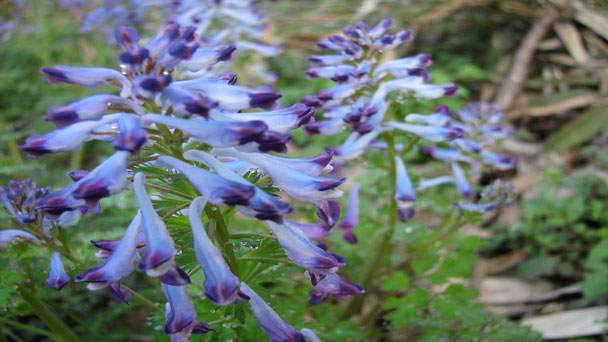
Essential for a cool garden, corydoria is sprayed early in the season with bright flowers and delicate leaves. Finding plants that flower well in shady conditions can be a bit of a challenge, but corydalis can easily light up even in deep shade. Lace, fern leaves appear in late winter, from early spring to early summer, and sometimes even longer, clusters of small, tubular, often fragrant flowers cover the plant.
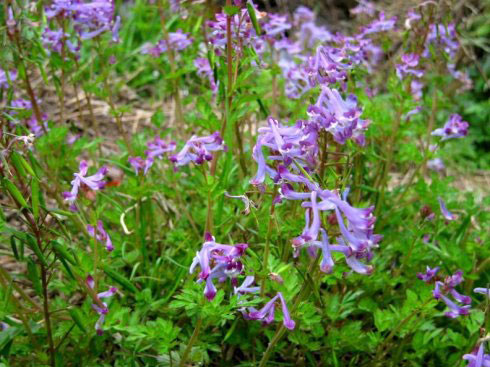
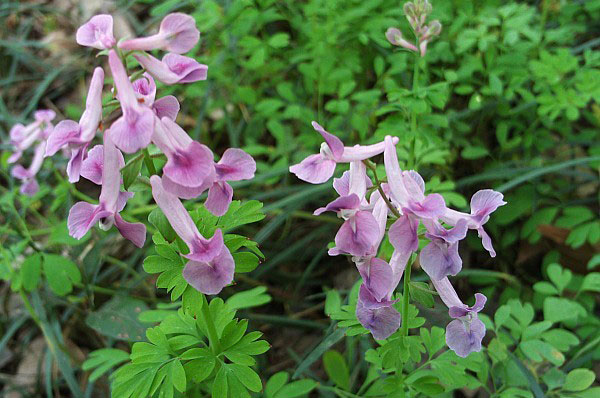
For propagation by seeds, you can use planting material collected from garden plants. When using such seeds, flowers are protected only by specific, and not varietal characteristics, therefore, the appearance of the resulting bushes can be strikingly different from the mother flowers.
Sowing is carried out in the summer months, using small flower greenhouses with transparent lids or individual cups.
There should be drainage holes at the bottom of the container, and for the first time, a moisture-wicking layer in the form of expanded clay or broken brick is laid.
The cups are filled with soil consisting of sod and leaf humus, peat with a large amount of river sand in the composition. Seeds are sown to a depth of about 0.5 – 1 cm, covered with earth and thoroughly moistened with a spray bottle.
Planting seedlings in open ground is carried out in the spring when the snow melts and the last night frosts leave. The first buds will be decorated with Corydalis plant grown from seeds for 3-4 years of life and often on each bush there will be only 1 – 2 flowers.
For division, a sharpened, sterile knife is used. As a result of division, each part should receive its own root system with a renewal bud.
Do not worry if the delenka does not have tubers – after planting for some time, these plants will be able to form new nodules.
The wound surface, which appeared during division, is treated with charcoal powder or wood ash for drying and disinfection.
Delenka are seated in new areas and watered. It is worth placing such plants in partial shade – direct sunlight immediately after division can cause additional stress.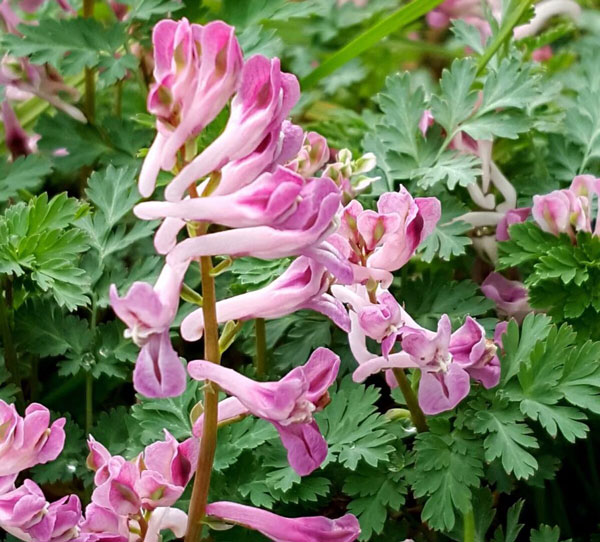
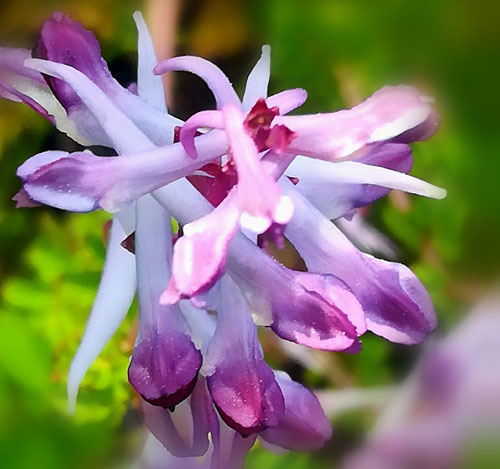
Corydalis plant is believed to relieve nervous tension, promote muscle relaxation and help lower blood pressure.
Plants also have antimicrobial properties, and therefore they are used to treat purulent wounds and trophic ulcers. Corydalis plant is used as a hemostatic and analgesic agent.
For medical purposes, all parts of the plant are used, from tubers to flowers, and they are harvested at different times. The green mass is cut off immediately after flowering – at this time it has the highest concentration of nutrients.
Tubers and rhizomes are dug out of the ground in the autumn months – during this period, the leaves managed to transfer all the reserves of nutrients to them.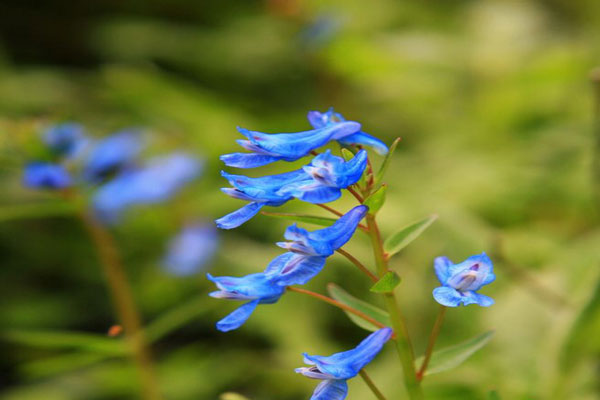
A widespread variety in horticultural culture, on the basis of which many modern varieties and hybrids have been bred. Represents compact plants up to 15 – 30 cm high with dissected leaves with rounded segments.
Corydalis Solida Beth Evans
Blooming perennials up to 25 cm high with delicate, light green leaves and large pink buds. The center of the flowers is often colored lighter, pink.
Corydalis ‘george Baker’
Small bushes grow up to 15 – 30 cm and during the flowering period they throw out peduncles with large inflorescences of bright and large flowers of a red or pink hue.
Corydalis Yellow – Corydalis Lutea
The Corydalis lutea is quite a large corydalis, widespread in Europe. It is a decorative perennial with emerald green leaves and small inflorescences on the tops of the shoots. The buds are painted in a bright yellow shade. The flowering period can come at any time from May to September. Corydalis lutea reaches a height of 30 – 45 cm.
Corydalis Hollow – Corydalis Cava
Most often used in traditional medicine. Plants are native to Turkey, Iran and the Caucasus. Early flowering perennials up to 15 cm in height. Plants of this species need cool stratification during seed propagation. When grown outdoors, may be prone to rot.
Corydalis Marshall – Corydalis Marschalliana Pers
The corydalis subspecies is hollow, characterized by cream or pale yellow flowers. In its natural habitat, it grows in the Balkans, Crimea, the Caucasus and north-west Iran.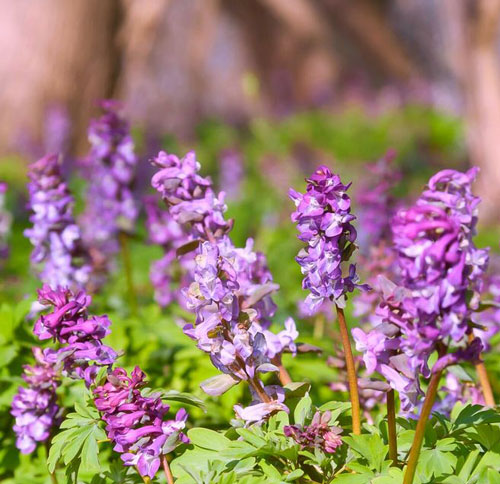
Corydalis (Fumewort) PictureCorydalis (Fumewort) InfoEcological Habits of Corydalis (Fumewort)Corydalis (Fumewort) Distribution AreaHow to Grow and Care for Corydalis (Fumewort)Uses of Corydalis (Fumewort)Varieties of Corydalis (Fumewort)Corydalis (Fumewort) Common Pests/DiseasesCorydalis (Fumewort) Companion Plants
Corydalis (Fumewort) Picture

Corydalis (Fumewort) Info
| Botanical Name | Corydalis canadensis |
| Common Name | Fumewort, hollow wort, turkey corn |
| Plant Type | Perennial |
| Mature Size | 12 to 18 inches |
| Sun Exposure | Shade to partial sun |
| Soil Type | Rich, well-drained, slightly alkaline |
| Soil pH | 5.0 - 7.0 |
| Bloom Time | Spring |
Ecological Habits of Corydalis (Fumewort)
Corydalis are low growing annuals, biennials or tuberous perennials with slender stems and small clumps of lush-green foliage. Tubular flowers form showy clustered sprays that neatly decorate the foliage throughout spring. They are best planted in flower beds and borders within cottage, informal and wildflower gardens. You should expect to see Corydalis grow to an approximate height and spread of 15-50cm (6-20”) dependant on variety.Corydalis (Fumewort) Distribution Area
The plant is widespread in the temperate zone of the Northern Hemisphere. The largest number of species grows in China, where they are located in the highlands.
How to Grow and Care for Corydalis (Fumewort)
How to Grow Corydalis (Fumewort)
- With Seeds
For propagation by seeds, you can use planting material collected from garden plants. When using such seeds, flowers are protected only by specific, and not varietal characteristics, therefore, the appearance of the resulting bushes can be strikingly different from the mother flowers.
Sowing is carried out in the summer months, using small flower greenhouses with transparent lids or individual cups.
There should be drainage holes at the bottom of the container, and for the first time, a moisture-wicking layer in the form of expanded clay or broken brick is laid.
The cups are filled with soil consisting of sod and leaf humus, peat with a large amount of river sand in the composition. Seeds are sown to a depth of about 0.5 – 1 cm, covered with earth and thoroughly moistened with a spray bottle.
Planting seedlings in open ground is carried out in the spring when the snow melts and the last night frosts leave. The first buds will be decorated with Corydalis plant grown from seeds for 3-4 years of life and often on each bush there will be only 1 – 2 flowers.
- With Rhizomes
For division, a sharpened, sterile knife is used. As a result of division, each part should receive its own root system with a renewal bud.
Do not worry if the delenka does not have tubers – after planting for some time, these plants will be able to form new nodules.
The wound surface, which appeared during division, is treated with charcoal powder or wood ash for drying and disinfection.
Delenka are seated in new areas and watered. It is worth placing such plants in partial shade – direct sunlight immediately after division can cause additional stress.

How to Care for Corydalis (Fumewort)
- Light
- Soil
- Water
- Temperature and Humidity
- Pruning

Uses of Corydalis (Fumewort)
The flower is used in folk medicine to treat many diseases, but it should be used with caution – the plant is poisonous. Large doses of plant materials can cause severe poisoning; you should also not use bushes during pregnancy and breastfeeding.Corydalis plant is believed to relieve nervous tension, promote muscle relaxation and help lower blood pressure.
Plants also have antimicrobial properties, and therefore they are used to treat purulent wounds and trophic ulcers. Corydalis plant is used as a hemostatic and analgesic agent.
For medical purposes, all parts of the plant are used, from tubers to flowers, and they are harvested at different times. The green mass is cut off immediately after flowering – at this time it has the highest concentration of nutrients.
Tubers and rhizomes are dug out of the ground in the autumn months – during this period, the leaves managed to transfer all the reserves of nutrients to them.

Varieties of Corydalis (Fumewort)
Corydalis Dense Or Haller -Corydalis SolidaA widespread variety in horticultural culture, on the basis of which many modern varieties and hybrids have been bred. Represents compact plants up to 15 – 30 cm high with dissected leaves with rounded segments.
Corydalis Solida Beth Evans
Blooming perennials up to 25 cm high with delicate, light green leaves and large pink buds. The center of the flowers is often colored lighter, pink.
Corydalis ‘george Baker’
Small bushes grow up to 15 – 30 cm and during the flowering period they throw out peduncles with large inflorescences of bright and large flowers of a red or pink hue.
Corydalis Yellow – Corydalis Lutea
The Corydalis lutea is quite a large corydalis, widespread in Europe. It is a decorative perennial with emerald green leaves and small inflorescences on the tops of the shoots. The buds are painted in a bright yellow shade. The flowering period can come at any time from May to September. Corydalis lutea reaches a height of 30 – 45 cm.
Corydalis Hollow – Corydalis Cava
Most often used in traditional medicine. Plants are native to Turkey, Iran and the Caucasus. Early flowering perennials up to 15 cm in height. Plants of this species need cool stratification during seed propagation. When grown outdoors, may be prone to rot.
Corydalis Marshall – Corydalis Marschalliana Pers
The corydalis subspecies is hollow, characterized by cream or pale yellow flowers. In its natural habitat, it grows in the Balkans, Crimea, the Caucasus and north-west Iran.

Corydalis (Fumewort) Common Pests/Diseases
The corydalis plant has an enviable resistance to a variety of diseases and pests. In lowlands and areas of stagnant water, plant roots may rot. When humidity is too high and air circulation is insufficient, fungal diseases can occur. Viral diseases show up in leaves with spots and deformed buds that are different from flowers, and the affected plants cannot be treated -- they are destroyed. When planted outdoors, moles and small rodents can taste the roots of the flowers. Nematodes attack the tubers of harmful insects.Corydalis (Fumewort) Companion Plants
Hosta
This plant hardly grown 40 years ago is now one of the most commonly grown garden plants. But hosta has earned its spot in the hearts of gardeners—it's among the easiest plants to grow, as long as you have some shade and ample rainfall. Hostas vary from tiny plants suitable for troughs or rock gardens to massive 4-foot clumps with heart-shape leaves almost 2 feet long that can be puckered, wavy-edged, white or green variegated, blue-gray, chartreuse, emerald-edged—the variations are virtually endless. Hostas in new sizes and touting new foliage features seem to appear each year. This tough, shade-loving perennial, also known as plaintain lily, blooms with white or purplish lavender funnel-shape or flared flowers in summer. Some are intensely fragrant. Hostas are a favorite of slug and deer.Solomon's Seal
This elegant shade plant has gently arching stems and dangling creamy bells. Solomon's seal adds height and grace to shaded gardens in spring. It's an easy plant to grow, and will slowly colonize—even in tough areas where shallow tree roots rob moisture and nutrients. The foliage turns golden in fall.Barrenwort
Barrenwort is a rare plant, one that thrives in the dry shade beneath shallow-rooted trees! It spreads at a moderate rate, forming a graceful, dense groundcover. Almost as a bonus, it also produces dainty flowers shaped like a bishop's miter, prompting another common name: bishop's cap. Its colorful foliage dangles on slender stalks, providing yet another moniker: fairy wings.
Latest Updated
- Benefits of Bugleweed - 7 Science-backed Health Benefits
- Bugleweed Dangers & Side Effects - Is It Poisonous?
- How to Plant Evergreen Trees - What You Should Know
- When to Plant Evergreens - Grow Guide for Evergreen Trees
- 12 Wonderful Evergreen Shrubs for Your Garden
- 12 Popular Evergreen Plants with Pictures for Beginners
- When And How To Prune A Lilac Bush Like a Pro
- How to Grow & Care for Lilac Vine (Hardenbergia Violacea)
- Japanese Lilac Tree (Syringa Reticulata) Care & Propagation Guide
- Shumard Oak Pros and Cons - What to Know
Popular Articles
- Winter maintenance of Antirrhinum Majus
- How to Grow Terminalia Mantaly Tree
- How to Grow and Care for Crossostephium Chinense
- How to grow Antirrhinum Majus in spring
- Peristeria Elata (Dove Orchid) Profile: Info & Care Guide
- Underwatered Snake Plant (Sansevieria Trifasciata) - Signs And How To Fix
- How to Care for Brazilian Jasmine Plant (Mandevilla Sanderi)
- How to Grow & Care for Graptopetalum Purple Delight in Summer
- Rosa Chinensis (China Rose): Plant Growing & Care Tips
- How to Care for Baby Sun Rose (Aptenia Cordifolia)